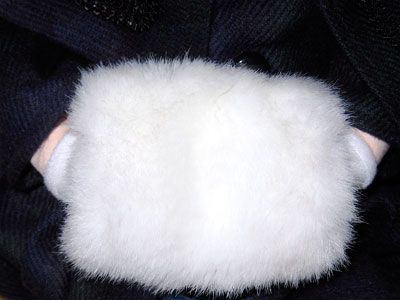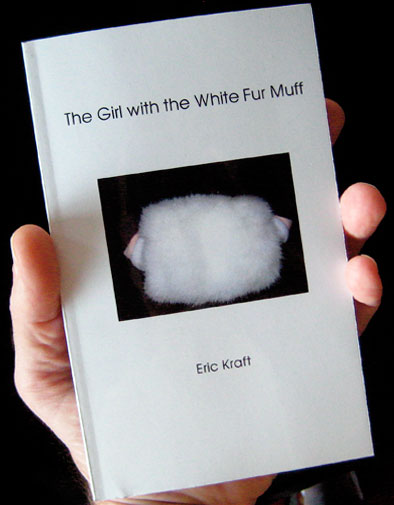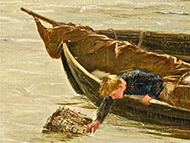
THE GIRL WITH THE WHITE FUR MUFF is included in LITTLE FOLLIES. However, it is also available on its own as a pocket-size paperback. |
||
| The Babbington Press (2008) 76 pages 4.25 inches by 6.88 inches $ 10.95 |
||
| DIGITAL EDITIONS |
The Girl with the White Fur Muff
(a sample)
Chapter 1
WHEN REPORT CARDS were handed out at the Babbington Grammar School, some of my classmates fell into a whimpering terror, instinctively cowering and covering their vulnerable spots, as skittish and apprehensive as squirrels. Others began whooping and crowing, pounding one another on the back, and totting up their spoils. At the time it didn’t occur to me to pity the first group, but I certainly envied the second, for my parents considered it a Principle of Child Rearing not to reward my accomplishments in school.
When I brought a report card home, I got small praise for even the best of grades, and almost nothing in the way of tangible rewards. My father would say, looking at the best report card in my class, or even in the whole school, “That’s what I expected.” Sometimes Gumma or Guppa would slip me a dollar, or my mother would give me a hug and whisper, “I’m proud of you, Peter,” but these tokens seemed insignificant indeed beside the handsome cash prizes some of my friends collected. Some were paid for meeting certain standards, negotiated with their parents in advance, standards that were often, it seemed to me, quite low for the loot involved. Others were rewarded for showing any improvement at all; quite a few made out pretty well just for getting through six weeks without being sent to the principal’s office; and still others could collect a metal dump truck or a movie pass just for compiling a decent attendance record. It didn’t seem just.
However, on the extraordinary occasion when Matthew Barber and I were, after three weeks in the third grade, moved ahead to the fourth, I did get a reward: a camera, the first I had ever owned. It was small, well suited to the hands of a third-grader, but it was an unusual possession for a child in those times, a sophisticated gadget even for a fourth-grader.
The camera was made of black plastic, the kind called Bakelite. In overall shape, it was a cube, but a cube on which every edge had been smoothly rounded, as if the designer had streamlined it in case the photographer had to use it in a high wind. On each side was a vertical slide of bright metal that traveled in a channel molded into the Bakelite, so that, by moving these slides toward the top, one could separate the front and back halves of the camera to load or unload the film or to examine the interior. At its upper end, each metal slide terminated in a circular lug, through which were threaded the ends of a braided plastic strap. In the center of the back was a round window of translucent red plastic through which one could see the numbers on the paper backing of the film.
At the center of the front half was the lens, smooth and limpid, inside a crater of plastic. A short cream-colored shaft projected from a protuberance on the body. The top of the shaft was flattened to form the button that one pushed to take a picture. On the bottom of the camera was a knurled knob, also made of cream-colored plastic, that one turned to advance the film. Across the top of the camera, mounted in a channel molded into both halves of the body, was the viewfinder. When one held the camera with the viewfinder to one’s eye, the forefinger of one’s right hand fell quite naturally on the shutter button, and the middle finger fell quite naturally over the right half of the lens.
I loved that camera. I carried it with me everywhere for nearly a year, because holding it and looking at it reminded me that I had done something my parents regarded as extraordinarily worthy. But as much as the camera pleased me it intimidated me. A statement in the instruction booklet said, “Snapshots will capture your memories forever,” and I understood at once that the snapshots I was likely to take would capture forever memories of my childish ineptitude as a photographer, the evidence of my awkwardness and uncertainty. Clearly, the wise thing to do would be to avoid using film until I had acquired some poise, if only enough so that I wouldn’t take pictures I would really regret, so I put the film in the back of my sock drawer to save until I felt confident enough to use it.
For practice, I took filmless photographs, hoping that I’d become familiar enough with the camera to be able to handle it with skill and nonchalance. I trembled whenever I brought the viewfinder to my eye and tried to frame a picture. My finger froze on the white plastic button that would capture this memory forever, or would have if there had been film in the camera. I wanted to push the button, but some small consideration would always make me hesitate.
Maybe it would be better to aim a little higher, in case I might be cutting off the top of someone’s head.
If I waited just a moment, maybe Guppa would smile.
Was I too close?
Should I wait until the sun came out from behind that cloud?
Had I remembered to turn the knob after the last picture?
Maybe I should wait for another opportunity altogether.
Maybe I didn’t really want to preserve this memory at all.
Chapter 2
ON THE DAY when I left the third grade, my classmates threw a party for me. Everyone had brought cupcakes or cookies, and they had collaborated on a card that said GOOD LUCK, PETER. I was pleased, embarrassed, and moved. When it was time to go, I stood at the door with my hand on the knob. I swallowed hard. I thought that I ought to say something.
At this point I had one of those flashes of inspiration that go off in one’s brain now and then like a flashbulb or a bolt of lightning. I said, “I’d like to take a picture of all of you so I can be sure that I’ll never forget you.”
I had all my classmates gather at one end of the room for a group portrait. I spent some time moving them around to get a good composition, and then I said, “Okay, everybody, that looks just perfect. Now everybody smile.” Everybody smiled, and I held the camera to my eye. The familiar uncertainty gripped me, and my finger trembled over the button. I clamped my teeth together, closed my eyes, and pushed.
“Okay, everybody, you can relax now,” I called out. I wound the knob on the bottom of the camera. “You know,” I said, “snapshots capture your memories forever.”
I wasn’t using film in the camera, of course, so my memories began to fade as soon as I walked out the door.

|
|
|
|
|
|
|
|
|
|

